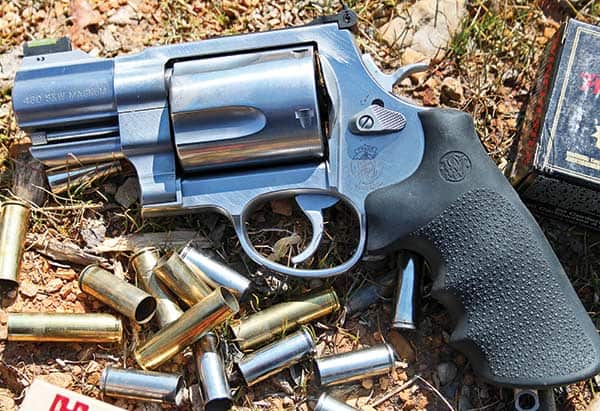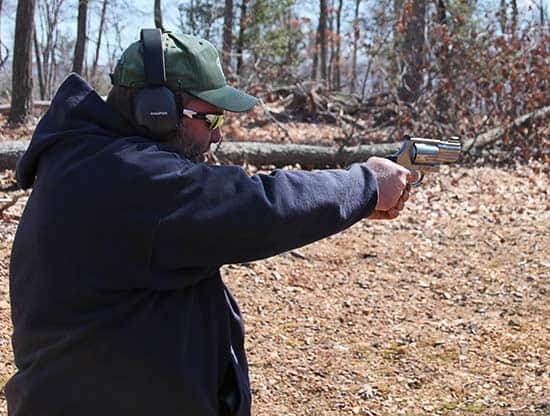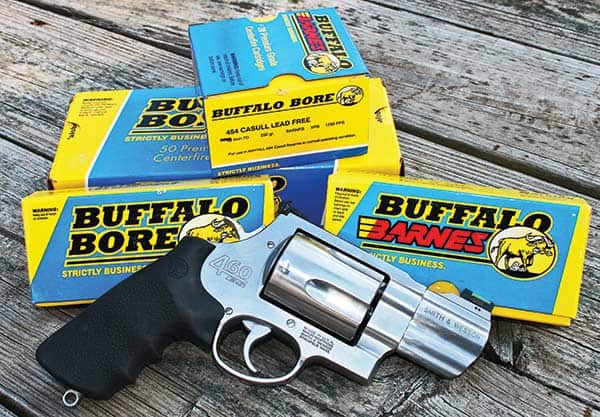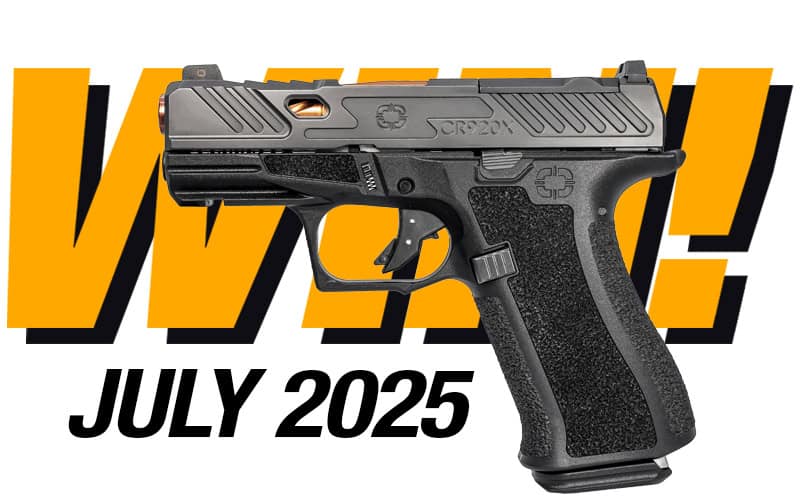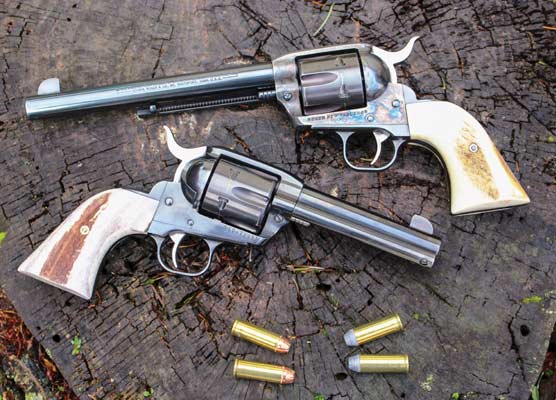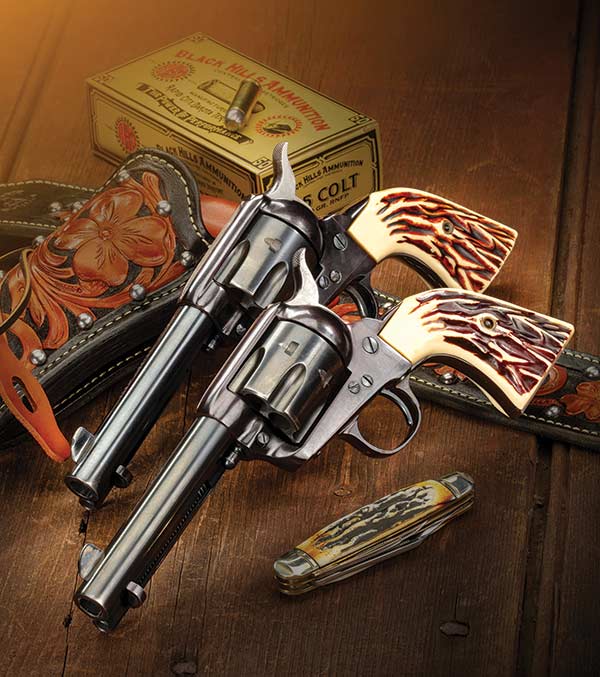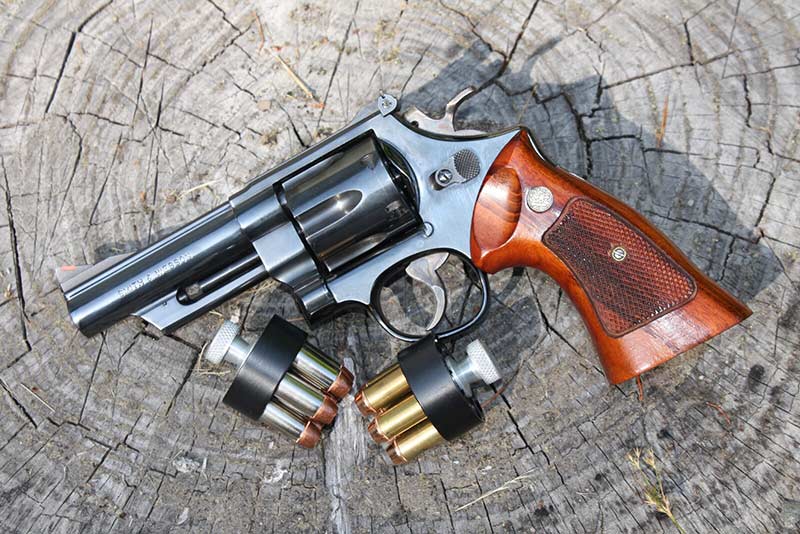S&W’s “Snubbie On Steroids”
A Short-Barreled .460 S&W Magnum
X-Frame Is A “Packable Powerhouse.”
In terms of marketing, the mantra of “bigger is better” should never be underestimated — especially when it comes to handguns. The huge Smith & Wesson X-Frame 5-shot revolver chambered in .500 S&W is proof of this. Upon its introduction in 2003 it was heralded as the most powerful production revolver in existence — a title it still holds. S&W quickly followed up with a .460 S&W Magnum X-Frame in 2005. The .460 S&W XVR (Xtreme Velocity Revolver) has the distinction of being the fastest handgun cartridge. It fires a 200-grain bullet at over 2,300 fps.
However, the new 2-3/4″ barreled variant makes the term “snubnosed” an oxymoron. The revolver is still massive — yet, surprisingly, not totally devoid of carryability or handling qualities.
Most of the long-barreled X-Frame offerings are geared toward handgun hunting. This newer short-barreled version was conceived as a backup option for outdoorsmen who inhabit the same locale as big and potentially dangerous animals such as grizzlies.
The XVR .460 S&W’s 5-shot cylinder is 1.920″ in diameter and 2.305″ long; it dwarfs the S&W N-Frame .44 Magnum cylinder. The gun is constructed primarily of stainless steel — weighing over 60 oz.
The 5-shot cylinder was a conscious decision based on the added strength of keeping as much steel between the charge holes as possible. Plus, the 5-shot design allows the bolt-notch cuts to be offset.
Unlike other S&W revolvers, the cylinder yoke-to-frame lockup does not utilize a center-pin running through a hollow ejector rod, nor is there any barrel lug latch. The solid, small-diameter ejector rod is unsupported at the front, but the frame latches the yoke directly with a spring-loaded ball detent.
While the X-Frame is obviously larger and thicker than its predecessors, the grip frame portion is the same as a K- or L-Frame S&W. There is a caveat to this. The Hogue Monogrip designed for the X-Frame is a full, wraparound-type with recoil-cushioning internal Absorbathane inserts within the upper web portion. All other Hogue Monogrips for S&W revolvers have an open backstrap. Thus, the grip on the X-Frame permits thicker, closed, back-cushioning design without increasing the overall diameter of the grip beyond what feels comfortable in an average-sized hand.
The 460XVR series of revolvers employs a new method of barrel attachment. The X-Frame uses a two-part barrel assembly consisting of an internal rifled barrel tube, and a separate barrel shroud. During assembly, the shroud is first placed over the index tabs on the front of the frame, and then the barrel tube is inserted and threaded into the frame with an enlarged ring around its muzzle bringing the shroud tightly against the frame as it torques down. The result is the barrel gets supported at both ends, not just at the rear, which enhances accuracy potential.
Also, significant is having the barrel threaded through the frame at the forcing cone, which must absorb all the punishing impact of the bullet as it leaps from the face of the cylinder.
Options For Powering Down
The ability to use .45 Colt and .454 Casull in the .460 S&W XVR is what distinguishes it from its .500 S&W sibling in terms of flexibility. The .460 is a lengthened, more powerful version of the popular .454 Casull, itself a longer and more powerful version of the .45 Colt. Consequently, firearms that fire .460 S&W Magnum are usually capable of firing the .454 Casull, and .45 Colt rounds. (The .45 Schofield also usable.)
Smith & Wesson claims the .460 S&W Magnum is the highest velocity revolver cartridge in the world, firing bullets at 2,330 fps. With Buffalo Bore’s new heavyweight loading, the .460 S&W Magnum can achieve nearly 2,900 ft-lbs. of energy by driving a 360-grain bullet at 1,900 fps. The .460 achieves high velocities by operating at pressures normally reserved for magnum rifle cartridges. Recoil is commensurate with the power level, so be prepared!
I was pleasantly surprised by the variety of ammunition available in .460 S&W and .454 Casull. Hornady and Winchester are well known manufactures offering loads as well as Buffalo Bore and DoubleTap. It’s a good idea to familiarize yourself with the .460 S&W Mag and .454 Casull loads and spend most of your time firing .45 Colt. I am sure I am not the first to come up with this policy. Anyone who has spent any amount of time firing the full power .460 S&W Magnum or .454 Casull rounds will arrive at the same conclusion.
While not life threatening, recoil is substantial to say the least in the 2-3/4″ 460XVR tested. Anyone who says different is trying to entice you into something unexpected for their own perverse entertainment.
I decided the more the merrier when it came to firing the full-powered loads during T&E. One drill involved firing a full cylinder of .45 Colt, then .454 Casull, finally .460 S&W Mag. As anticipated the .45 Colt was pretty tame in the 60 oz. revolver.
We expected a step up with the .454 Casull from the .45 Colt, culminating with the wrist twisting .460 S&W. However, there was very little difference experienced between the .454 Casull and .460 S&W Mag — both were equally stout.
Remember, the “snubbie” .460 S&W we were using was not equipped with a muzzle brake typical of other X-Frames. One enthusiastic soul fired five rounds one-handed while moving backwards, to simulate a bear attack. A large stump located on the side of the range played the role of the bear. While this proved doable, especially if considering the dire consequences of a real bear attack, it was not repeated many times with the .454 Casull or .460 S&W Mag loads.
The .460 S&W XVR functions like a double-action revolver and shares aesthetics with other S&W’s, albeit a super-sized version. The large cylinder swings out for easy removal of empties and recharging. The 2-3/4″ barrel features a HIVIZ fiber-optic front sight with the rear sight a standard S&W adjustable.
The double-action pull was smooth with no hitches measuring just under 10 lbs. The single action was crisp at 4 lbs. This is an ideal trigger for a revolver like the .460 S&W XVR “snubbie.” The revolver functioned perfectly during all testing, handling a plethora of factory loads from Buffalo Bore, Hornady, Winchester, Federal and DoubleTap.
The 460XVR snubbie is big — actually it’s huge! But the 2-3/4″ barrel allows it to be a belt gun, increasing its handiness. It is not an ideal candidate for new shooters firing .454 Casull or .460 S&W Magnum loads for the first time. However, if you are confronted at bad breath distances by a dangerous animal, at least you know the power of your holstered 460XVR revolver is only surpassed by large-bore rifles.
Buffalo Bore Ammunition
Buffalo Bore Ammunition entered the market with the intent of offering individuals who do not reload access to more specialized ammunition. Initial loads were for the .475 and .500 Linebaugh.
Owner Tim Sundles hunts in Alaska often and spends much of his time in big bear country. So he knows firsthand how important a big-bore revolver can be when you are considered part of the food chain.
Buffalo Bore has made its name with “heavy” +P+ loads in numerous calibers. The company stresses quality control with its custom manufactured ammunition. Sundles randomly tests for pressures and fires his ammunition in real firearms — not specialized pressure barrels. This process is followed with listing of velocities for specific Buffalo Bore ammunition from actual production weapons. You can rest assured any listed velocity on a Buffalo Bore box of ammunition is a realistic one.
Another Buffalo Bore specialty is the use of hard cast, lead flatnose bullets. Sundles is a believer in the effectiveness of a large frontal meplat in wreaking havoc. All of this goes back to Elmer Keith and John Taylor’s theories about large and relatively slow-moving bullets and their effect on large game. The large frontal meplat of a hard cast bullet creates a hydraulic wave when entering an animal, pushing everything out of its way and causing wound expansion while its solid construction translates to weight retention. A .45 caliber bullet doesn’t need to expand much to begin with, and with a frontal area of .330″, we are basically starting out with a .338!
If you want more velocity, penetration and “knockdown” power than you’re getting with standard loads, then you should definitely check Buffalo Bore out. And one of the great things about custom ammunition makers like Buffalo Bore is their willingness to support some of the lower-volume niche calibers. Buffalo Bore’s listing of calibers is impressive, as is the wide-ranging types of bullets they load.
For More Info
Smith & Wesson
www.smith-wesson.com
Buffalo Bore Ammunition
www.buffalobore.com
Echo Valley Training Center
www.echovalleytrainingcenter.com
Federal Premium Ammunition
www.federalpremium.com
Hornady Mfg. Inc.
www.hornady.com
Winchester Ammunition
www.winchester.com
